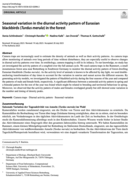New publication in the Journal of Ornithology [20.09.23]
Jan Dvorak from the Department of Food Informatics is Co-Author of the publication "Seasonal variation in the diurnal activity pattern of Eurasian blackbirds (Turdus merula) in the forest" in Journal of Ornithology (Impact Factor: 1.3 (2022)).The publication "Seasonal variation in the diurnal activity pattern of Eurasian blackbirds (Turdus merula) in the forest" by Xenia Schlindwein (Department of Biology, Eberhard Karls University Tübingen, Tübingen, Germany) with the co-authors, Christoph Randler (Department of Biology, Eberhard Karls University Tübingen, Tübingen, Germany), Nadine Kalb (Department of Biology, Eberhard Karls University Tübingen, Tübingen, Germany), Jan Dvorak (Department of Food Informatics and Computational Science Hub, University of Hohenheim, Stuttgart, Germany), Thomas K. Gottschalk (University of Applied Forest Sciences Rottenburg, Rottenburg, Germany) was published in Journal of Ornithology, Springer (Impact Factor: 1.3 (2022)).
Camera traps are increasingly used to estimate the density of animals as well as their activity patterns. As camera traps allow monitoring of animals over long periods of time without disturbance, they are especially useful to observe changes in diurnal activity patterns over time. In ornithology, camera trapping is still in its infancy. To our knowledge, no study has yet investigated the activity pattern of a songbird over the full annual cycle. We used camera traps in the Rammert, a small mountainous forest area near Rottenburg in Southwest Germany to monitor the diurnal activity pattern of forest-dwelling Eurasian blackbirds (Turdus merula). As the activity level of animals is known to be affected by day light, we used double anchoring transformation of day times to account for the variation in sunrise and sunset across the different seasons. By generating activity models, we investigated the pattern of blackbird activity during the four seasons of the year and compared the patterns of male and female birds, respectively. A significant difference between a unimodal activity pattern in spring and a bimodal pattern for the rest of the year was found which might be related to breeding and territorial behaviour in spring. Moreover, we observed that the activity pattern of males and females overlapped greatly but still showed some variation in the number and timing of density peaks.
The publication is available at: link.springer.com/10.1007/s10336-023-02096-2


